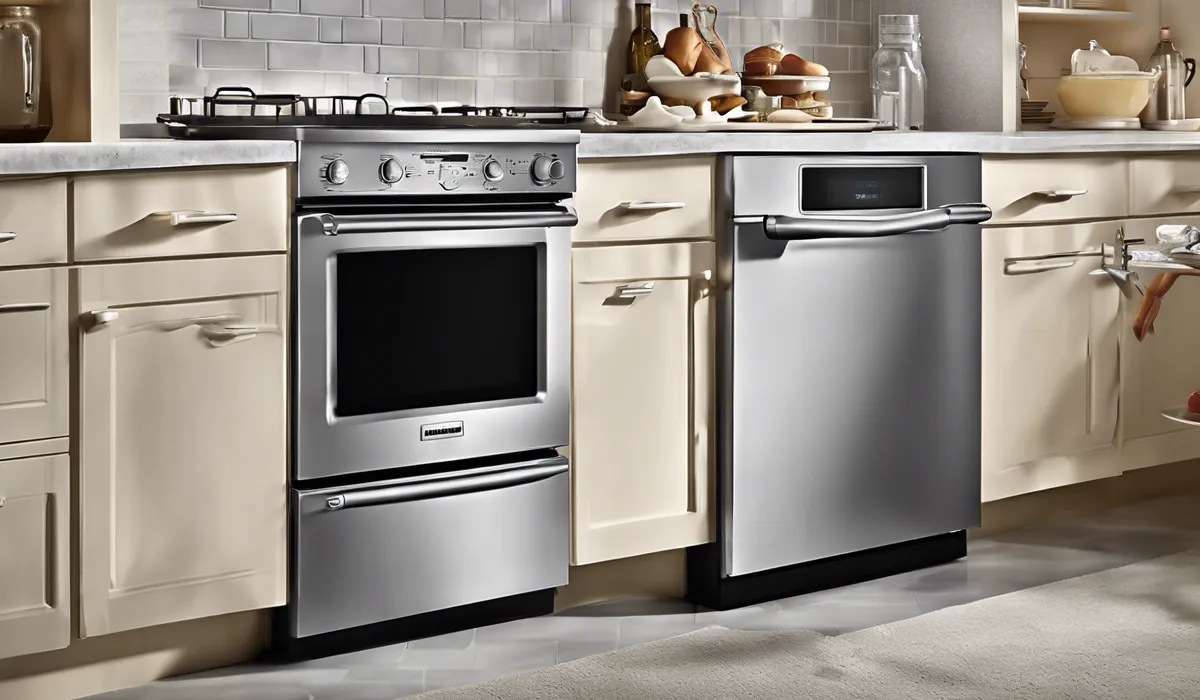Does KitchenAid Dishwasher Heat Water? Unveiling the Truth!
Yes, KitchenAid dishwashers are equipped with a heating element that heats water during various wash and rinse cycles. This ensures effective cleaning and sanitation by reaching the necessary temperatures to dissolve detergent and eliminate bacteria.
Understanding How KitchenAid Dishwashers Heat Water

Explanation of the Built-In Heating Element
KitchenAid dishwashers come equipped with a built-in heating element, which is a critical component in the appliance’s ability to clean dishes effectively.
This element is typically located at the bottom of the dishwasher and resembles a thin, metal loop or coil.
Its primary function is to raise the temperature of the water that enters the dishwasher to a level ideal for dissolving detergent and ensuring a thorough clean.
The Role of the Heating Element in the Dishwasher Cycle
During a wash cycle, the heating element activates at specific times to heat the water. It works by converting electrical energy into heat, which is then transferred directly to the water.
This process is essential for the dishwasher’s ability to break down food particles and grease, contributing to a more effective wash.
Dishwashers and Water Temperature Settings
KitchenAid dishwashers offer a range of water temperature settings that cater to different levels of soil on dishes. These settings are designed to provide the best balance between effective cleaning and energy consumption.
The user can select a higher temperature for heavily soiled items, ensuring that tough food residues are easily removed.
The Importance of Hot Water for Effective Cleaning and Sanitization
Hot water is a key factor in the dishwashing process for several reasons. It helps to dissolve detergent more quickly, improving its cleaning action.
Additionally, high temperatures are necessary to kill bacteria and other pathogens, ensuring that dishes are not only visually clean but also sanitized for safe use.
Advantages and Disadvantages of Dishwashers Heating Water

Energy Efficiency Considerations
While having a dishwasher heat its own water provides advantages in terms of cleaning power, it also raises questions about energy efficiency.
The dishwasher’s heating element consumes electricity, and depending on the local cost of electricity, this might affect the household’s energy bills.
Nonetheless, modern KitchenAid dishwashers are designed to be energy efficient, often bearing the ENERGY STAR certification, which assures users of their eco-friendly design.
Impact on Cleaning Performance
The ability of a dishwasher to heat water to the optimal temperature can significantly impact cleaning performance.
Water that is too cold may not effectively remove oil and grease, while water that is too hot can cause damage to delicate dishes.
The heating element in KitchenAid dishwashers is calibrated to ensure the water reaches the ideal temperature for both cleaning and protecting dishes.
Wear and Tear on the Dishwasher’s Heating Element
Over time, the continuous use of the heating element can lead to wear and tear. This can result in a less efficient operation or, in some cases, the need for repairs or replacement.
However, regular maintenance can help extend the life of the heating element and ensure it continues to perform effectively.
Comparison with Using Pre-Heated Water from Home’s Water Heater
Some might wonder how using a dishwasher’s heating element compares to using pre-heated water from the home’s water heater.
While the latter can be more energy-efficient, especially if the home is equipped with a high-efficiency water heater, the dishwasher’s heating element ensures the water temperature is specifically tailored for dishwashing tasks.
Tips for Optimizing Dishwasher Water Heating

Selecting the Appropriate Cycle for the Level of Soil
To maximize the efficiency of your KitchenAid dishwasher, it’s crucial to select the cycle that matches the level of soil on your dishes.
Lightly soiled items do not require as high temperatures or as long wash times as heavily soiled pots and pans.
By matching the cycle to the soil level, you can save energy while still achieving clean, sanitized dishes.
Maintenance Tips for the Heating Element
Regular maintenance of the heating element is essential for its longevity and effectiveness.
This includes periodically checking the element for any signs of damage and ensuring that it is free from debris and mineral buildup, which can insulate the element and reduce its efficiency.
If you notice any issues, contacting a professional for repair or replacement is recommended.
Best Practices for Loading Dishes for Optimal Water Heat Distribution
How you load your dishwasher can affect how well the water and heat are distributed. Ensure that there is enough space between dishes for water to circulate.
Avoid overlapping items that can create cold spots and restrict the full reach of the hot water. Proper loading helps ensure that each dish benefits from the heated water and detergent, leading to a more uniform and effective clean.
Recommendations for Energy-Saving While Still Ensuring Effective Cleaning
There are several strategies to save energy while still getting your dishes clean. One is to run the dishwasher only when it is fully loaded, maximizing the use of water and heat for each cycle.
Also, selecting an eco-friendly cycle if available can reduce energy usage. Furthermore, you can ensure that your dishwasher is in good repair, as a well-maintained appliance is more efficient.
Lastly, you can consider washing dishes during off-peak hours if your energy provider offers variable rates, which can lead to cost savings.
FAQs About KitchenAid Dishwasher Water Heating
Does the KitchenAid dishwasher have a water heater?
Yes, KitchenAid dishwashers are equipped with a heating element that heats the water during wash and rinse cycles.
Do KitchenAid dishwashers heat water to a temperature that can sanitize dishes?
Yes, the heating element in KitchenAid dishwashers heats the water to temperatures that can dissolve detergent effectively and sanitize dishes by eliminating bacteria.
Is it necessary to connect a KitchenAid dishwasher to a hot water supply?
It is not strictly necessary as KitchenAid dishwashers have a built-in heating element, but connecting to a hot water supply can reduce cycle times and energy use.
How hot does a KitchenAid dishwasher heat the water?
The exact temperature can vary by model, but KitchenAid dishwashers generally heat water to a temperature high enough to ensure effective cleaning and sanitation.
Can I adjust the water temperature on my KitchenAid dishwasher?
Most KitchenAid dishwasher models have pre-set wash cycles with specific temperatures for optimal performance, and these temperatures are typically not manually adjustable.
Final Thoughts
KitchenAid dishwashers come with a built-in heating element that raises water temperature during wash and rinse cycles.
This feature is essential for dissolving detergent properly and ensuring that dishes are not only clean but also sanitized by eliminating harmful bacteria through the use of sufficiently hot water.





